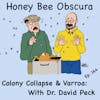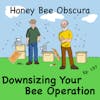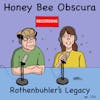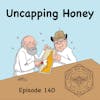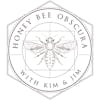Supplemental Spring Feeding of Honey Bees (069)
If your colonies make it through the winter, or if you simply purchased more bees as a package or nuc, their next challenge is making it through the changeable spring weather. (Especially this year, it seems.) Your management challenge is deciding...
 If your colonies make it through the winter, or if you simply purchased more bees as a package or nuc, their next challenge is making it through the changeable spring weather. (Especially this year, it seems.) Your management challenge is deciding what and how to feed them. In this episode, Jim Tew and Jeff Ott discuss supplemental spring feeding.
If your colonies make it through the winter, or if you simply purchased more bees as a package or nuc, their next challenge is making it through the changeable spring weather. (Especially this year, it seems.) Your management challenge is deciding what and how to feed them. In this episode, Jim Tew and Jeff Ott discuss supplemental spring feeding.
Specifically, they discuss the feeding of carbohydrates or sugar water. (The supplemental feeding of protein (pollen) will be covered in a future episode.) So how do you feed a sugar syrup? Use a Boardman entrance feeder? A hive top feeder? Division board feeder? Jim and Jeff (who is sitting in this week for Kim) discuss their experiences and pro's and con's of multiple types of feeders.
 Is there a preferred ratio for mixing water to sugar? Is tap water OK? What about additives?
Is there a preferred ratio for mixing water to sugar? Is tap water OK? What about additives?
What about ditching sugar solutions and going with fondant?
Decisions, decisions...
What is your preferred way of feeding in the springtime before the flowers are in full bloom? Let us know in the comments section of this episode! Start a discussion.
If you like the episode, share it with a fellow beekeepers and/or let us know by leaving a comment in the show notes. We'd love to hear from you!
Checkout this VideoMoment on hive top feeders from Jim Tew: https://youtu.be/CfKiHnmbzCU
___________________
Thanks to Betterbee for sponsoring today's episode. Betterbee’s mission is to support every beekeeper with excellent customer  service, continued education and quality equipment. From their colorful and informative catalog to their support of beekeeper educational activities, including this podcast series, Betterbee truly is Beekeepers Serving Beekeepers. See for yourself at www.betterbee.com
service, continued education and quality equipment. From their colorful and informative catalog to their support of beekeeper educational activities, including this podcast series, Betterbee truly is Beekeepers Serving Beekeepers. See for yourself at www.betterbee.com
______________________
Honey Bee Obscura is brought to you by Growing Planet Media, LLC, the home of Beekeeping Today Podcast.
Music: Heart & Soul by Gyom, Walking in Paris by Studio Le Bus, original guitar music by Jeffrey Ott
Photos copyright © One Tew Bee, LLC
Copyright © 2022 by Growing Planet Media, LLC

Episode 69 – Supplemental Spring Feeding of Honey Bees
[Music]
Jim Tew: Hey, listeners. It's spring of the year. During that time of the year, I usually do what I can to help feed my bees. In the book that's a simple process. In reality, it can be complicated. Jeff, how often do you feed bees? What's your idea?
Jeff Ott: Well, Jim, in the springtime, I'm always biting my nails because I never know the right way, right time, what mixture? I don't know. Yes, feeding is important. I try to feedback comb honey if I have it because I usually have a dead out or two.
Jim: That's good. Well, do you have time to talk about it? Let's go into this for a bit.
Jeff: Yes I do. Thanks.
Jim: Just to be sure everybody knows who we are. I'm Jim Tew.
Jeff: I'm Jeff Ott sitting in for Kim Flottum.
Jim: We're coming to you today from Honey Bee Obscura, where about once a week, we try to talk about essentially anything and everything about bees.
Introduction: You are listening to Honey Bee Obscura brought to you by Growing Planet Media, the folks behind beekeeping today podcast. Each week on Honey Bee Obscura, host Kim Flottum and Jim Tew, explore the complexities, the beauty, the fun and the challenges of managing honeybees in today's world in an engaging and informative discussion meant for all beekeepers, long-timers and those just starting their journey with bees. Sit back and enjoy the next several minutes as Kim and Jim explore all things honey bees.
Jim: Jeff, this feeding thing is deceptive because you think, let's just go give the bees some sugar syrup. They really appreciate that. That's the absolute basic concept of what's about to happen.
Jeff: That's the hundred thousand foot level. That's right.
Jim: That's it. Why? Why are we doing that, Jeff? Why would I go out right now to colonies that just survived the greatest dearth of this winter, of the season? They still have some honey on them-
Jeff: Maybe.
Jim: -and I'm going to put a feeder on. Why am I doing that?
Jeff: Because at this point in time of the year, as you pointed out, the flowers are only just starting coming up. Only the dandelions, and I know there's a controversy about dandelions now. Dandelions have historically, at least historically in my term of beekeeping, it's been the first sign of spring and the good thing for beekeepers because it's one of the earliest flowers to bloom. It's difficult time this time of year because there's very little in bloom, very little pollen sources, very little carbohydrates for the bees to eat. You want that colony to get up to speed quickly, so you supplement that feeding in the springtime.
Jim: I agree. That's in every textbook out there. I don't know always exactly how to do it, I think that I am stimulative feeding and until science tells me otherwise, I'm going to cling to that, that we are stimulating the bees. We are jostling their behavior to help them be eager, to help them pick up the brood production some so that they would produce more bees, more brood, ergo, more honey, and more pollination than they would in the wild with a smaller, more natural nest. I feed! I use different kinds of feeders, different kinds of feed concoctions. Most of the time, the best feed, didn't we luck out on that? Most of the time, the best feed is just common table sugar. You can buy at any grocery store anywhere.
Jeff: We're going to talk about basically feeding the carbohydrate, the sugar feeding. The whole topic of pollen substitutes is-- Well, that could take a whole another episode.
Jim: You're taking my thought away from it. I was going to say that we didn't luck out with feeding protein. We had to work on that a lot more. It took a lot longer. We have some excellent products out there now, but yes. Later on, some other episode, we can discuss pollen or protein feeding, which is not the same as carbohydrate feeding.
Jeff: We're talking about springtime feeding, just high level. That's different than fall feeding when you're trying to get them ready for the winter, correct?
Jim: My understanding of the fall feeding, winter feeding is that you're really serious. If you're ever going to actually heat the syrup and to drive it into solution and make the solution as concentrated as possible, that would be winter feed. You're feeding for storage and for survival. You wouldn't really do that in the spring because you want them to eat it and turn that into bees. You don't want them to store it and begin to make some honey syrup, honey concoction out of it, which is hard to do anyway.
Jeff: I always have to Google this. What is the ratio for the springtime feeding?
Jim: For the springtime feeding, it can be anything you want it to be, but probably around 50/50.
Jeff: 50/50?
Jim: I'm telling you that because I'm telling you the truth. I'm telling everyone who's listening the truth, because that's about as much sugar as I can readily dissolve in the hot tap water from my water heater. That's how I came up with this 50/50 thing. If the colony is starving, Jeff, and you're really worried that this colony is not going to make it, then jack it up. Heat the sugar syrup more on a stove somewhere and make the concentration thicker.
If it's just a colony that's got some honey stores on it, it looks pretty good, I'm going to help these bees along. That can be a lighter situation, but always keep in mind, you're feeding sugar, you're not feeding water. You're not really accomplishing anything by putting 5 pounds of sugar in 50 gallons of water. You've still just got five pounds of sugar and the bees are going to have to remove all that water to get to that dab of sugar.
Jeff: Is tap water fine?
Jim: Generally speaking, tap water is fine as opposed to, what, well water or--
Jeff: Bottled water, my Evian. Do I use Evian water? Do the bees prefer that?
Jim: We could say that. Here comes the comments and the letters now. You can top feed. You can use tap water. You can put bottled water or whatever in a top feeder. This is beyond the score. We've just got a few minutes here, but it's beyond the scope of this session. You basically feed (1) on top of the hive, you feed (2) in the hive, or (3) you feed outside the hive. Those are your three options. What are you using? What kind of feeders, out of all the myriad feeders available, what do you have?
Jeff: I've been experimenting with a top feeder lately, because I've found that when I wanted to feed, I didn't necessarily want to open up the entire hive to the outside, because it's never really warm here when I'm feeding. It's usually in the forties or fifties. I want to keep the heat in with the cluster. I've been experimenting with a top feeder that has two wells on both sides and a screen over it. The bees can come up from the hive, get into the feed and go back down, but I can take off the top and refill the feeder without both having bees fly around and also letting out all the heat.
Jim: You don't have so much chance of robbing started?
Jeff: Yes.
Jim: Our sponsor manufacturers some top feeders. It's a good time to take a break and let them talk to us.
Betterbee: Hey, podcast listeners, if you've got a couple of years of beekeeping under your belt and you are looking for a new challenge, available from Betterbee is the Hogg Halfcomb System, a mess-free comb honey system that you put on a strong hive for your bees to fill, made of 32 to 40 individual food-grade recyclable cassettes. It only takes popping off the covers and sticking on your labels to get your Halfcombs ready for sale. Visit betterbee.com/hogg today to learn more and start making your own mess-free comb honey.
Jim: All those years ago, Jeff, I actually built top feeders. Before they were available, before they were made of plastic, there were designs and plans and schemes for making these things just out of common pine boards and plywood. Didn't they leak? Well, sure they did, but you tried to stop that by coating the inside in what? Beeswax.
You coated all the inside with beeswax and then bending that thing, shifting, torquing, racking could cause it to leak. They were okay, but they did seep, S-E-E-P. That would just drive robber bees crazy, to have that little seeping coming through. What an improvement that was for these top feeders now to be made of plastic that's impervious to that leakage.
Jeff: I mostly like them. There have been times I wish I had the internal frame feeder. I think that would be easier for the bees, but then, I don't know. I go back and forth, but what I really do not like unless I absolutely need it. Boardman Feeders? I've never had one that worked well, and I think they are problematic.
Jim: You mean the entrance feeder, the Boardman Feeder that goes in the entrance?
Jeff: Correct
Jim: You're required to have one of those. If you're a beekeeper, you're required by some unspoken regulation to have a Boardman Feeder. (humor) That way you can feed the ants and the other robber bees in the community without having to open the colony to have it done.
Jeff: I lost that manual, but I do have two in shed. (Humor)
Jim: I agree with you completely, but they're just so typically beekeeping, and that was the first feeder I used to watch that sugar syrup bubble, bubble, bubble. I was doing my job. I was a good beekeeper. I'm doing what the book says do. I just love that thing. I agree with you completely. You're probably going to be limited to a quart capacity. It's easy for it to leak. You're attracting other bees right to the entrance of your colonies. On one hand, brain dead simple, on the other hand, really problematic about using it at all.
Jeff: Usually the bubble, bubble, bubble was it dripping down on the ground.
Jim: Was it leaking out?
Jeff: Yes, it was just leaking out and other bees eating it. I will say in Boardman Feeders defense is if you have the requirement to feed a medication, it does come in handy for that because you have the quart size and you can measure out whatever your treatment is.
Jim: It's simple. It's a good way to learn, but you probably want to move on to a Division Board Feeder, which is one of the feeders that can go inside near the bees. We can quickly mention fondant. There used to be recipes in the old books on how to make this stuff and it was miserable. I have never done it one time because you needed to be a cook. You had to heat the sugar-water solution.
Jeff: You had to put it at the right temperature. Temperature wise, You can't go above, you can't go below. You needed a candy thermometer.
Jim: You had to have a candy thermometer? What is that? I don't have a candy thermometer. Also, you got to put in, I think it was cream of tartar.. .
Jeff: Something...
Jim: Some recipes seemed like they had a little shot of vinegar. This just ain't going to happen, Jeff. Years ago, I went to a local commercial bakery, and not wanting to look totally stupid, I told the person who came to greet me that I was wondering if they knew what commercial product would be like the filler in an Oreo cookie®. The baker popped off, "That would be Karps #52 fondant." Not knowing what it was, I bought a 50-pound box of it, and it is just divinely sweet.
It's basically donut glaze. All the time you're cutting these chunks to go on the beehive, you just can't stop licking your fingers because it's the essence of heavenly sweetness. Sometimes feeding fondant doesn't leak, doesn't drip, doesn't cause robbing nearly as badly. If you make your own plan for this procedure, if you buy your own probably a 50-pound block, you’ve got to develop a relationship with the commercial baking supply, but that's an option.
Jeff, before somebody writes this and points out that it's got corn starch in it, yes, I do know that, but since I'm feeding it primarily in the springtime, I don't think it's going to be plugging up the bees. I haven't been able to see. There is that and there is some corn syrup in fondant mix but still, it's fondant, it's solid feed, works well.
Jeff: It'll get them through the rough spot because all we're trying to do at this point is get them through end of the winter, early spring lack of nectar.
Jim: Just trying to let them know that we're there to help. We're on their side. Here's a little bit of food. You may or may not need it, but we're trying to keep you pumped up. That's what beekeepers do. In all cases, try to help, don't hurt. One thing that you can do that I wish you wouldn't do, in general, listeners, and that's feed outside. I see it done all the time. I have people all the time who will tell me at meetings that they like to put those cappings outside and let the bees rob it out. “It's a little treat for them.” Well, actually, it's a vicious world out there.
The bees are fighting amongst themselves and killing each other over this “treat”. It's just chaos over what? A half a cup of honey. It gets robbing started. Feeding outdoors is the same thing. You can feed a shocking amount of syrup in a short, short time just by putting it outside. That's what the bees are accustomed to, but you feed all the bees in the neighborhood. You don't know whose bees you're feeding. You're homogenizing every known bee disease that you've ever seen. This is all happening at one time. Really works well. Probably not a great idea even though-- Commercial beekeepers, I know you sometimes do it. I've seen you do it, but for the rest of us, it's not a great idea.
Jeff: We've started out with the need to feed. We mixed maybe a one-to-one sugar to water mixture. Is that by weight, by volume or doesn't matter?
Jim: Yes, by volume. A quart jar - probably. I fill out about half full of sugar and then the rest of it by water.
Jeff: Warm water helps it.
Jim: Yes, as hot as I can get from the tap.
Jeff: We select our feeder choice whether be a top feeder or a Boardman Feeder or even a Division Board Feeder. What do you take it out to the beehive then?
Jim: I just have various kinds of common buckets. One of the gadgets is a feeder that attaches to the top of the telescoping cover. It's a hybrid. It's not really inside, not really a top feeder. You put about a gallon of feed in a container that then connects to the top of the colony and then the bees feed through a hole in the telescoping cover. When you use that, of course, it's got a handle on it, and you just carry it out to the beehive.
Otherwise, take a can and don't mix it in the bee yard. If you're feeding, you probably don't have a nectar flow. Always keep that in mind. Don't just stand there and spill syrup right by the beehives. Go spill it somewhere else.
Jeff: That's right. In your neighbor's driveway. Just kidding. (Humor)
Jim: I understand that very well. How about feeding honey back?
Jeff: Oh, that's a good one.
Jim: We have no time to mention that. We're almost out of time. If you've been keeping bees as long as you and I have, you just accumulate stuff. You accumulate old equipment. You accumulate old smokers. You'll be surprised how much old honey you've got sitting around. "Well, I want to feed that back to the bees." Well, go slowly.
The books will always admonish you that that's a possibility for spreading American foulbrood. That is a possibility. Probably small but don't ignore it. Cut that honey by at least 30% with hot water, mix it back up, turn into a thin honey solution and only feed what they can take overnight, has been my experience and that of others. You can let these bees reprocess honey for you. They are these consummate professionals at doing it.
Jeff: I had not ever had to cut it by 30% or cut it down to 30%.
Jim: They can take it straight, but think about cold honey. Think about how thick that is.
Jeff: Oh, makes a lot of sense. I like that. Feed it in a regular feeder, whatever your feeder of choice is?
Jim: Then feed it in whatever you're feeding in. Probably in my case, a top feeder. Who has tons and tons of old honey to feedback? I don't know. If you got honey that's granulated or whatever, it's a good way to get rid of it.
Jeff: My favorite is, and I mentioned it at the top of the show, was the frames of honey from dead outs. If I know that the colony died of starvation or the winter or varroa, more than likely, or died of related diseases, I take that frame and I put that in the hive that needs it. That's a readily available source for the bees. They know what to do.
Jim: We said that we weren't going to discuss it, but I do have to mention the fact that we are so lucky now to be able to feed protein. We have these other products and not just proteins. Some of them are vitamins. Honey-B-Healthy. I'm not naming these because I'm showing preference, but I want you to know these products didn't used to be available. You had to make your own out of brewer’s yeast and whatever. Strong Microbials, Global Patties. When you look at it, beekeepers can really come up with a remarkable menu of supplemental feed now.
Jeff: In our other podcast, Beekeeping Today Podcast, we also had one sponsor, HiveAlive, and it's made out of seaweed extract. The variety of what's available for beekeepers is remarkable. Of course, they're all available from our current sponsor, Betterbee. It can be mind-blowing. Just talk to your other beekeepers, find out what's working in your area and what they like to use and give it a try. It won't hurt them.
Jim: I'm already feeling badly about this segment because there's so much more we could have talked about, so much more we could have said. This is a good solid topic. This is a good way a beekeeper can help the colonies. Too much to discuss in 15 to 20 minutes. Do something, help them out.
Jeff: That's right. The important thing is recognizing the need that you need to feed them in the springtime, so they don't starve, because they're producing a lot of brood and the food consumption's going skyrocket at this time of year. Make sure they have food available, and you can do that whether you have a hive scale, or you use the heft method. Make sure they have food available. Supplement it as needed. Then they'll let you know when they don't need it anymore. They'll stop taking it.
Jim: Nicely said. I enjoyed talking to you. I appreciate the people who listen. I always appreciate them, until we can do this again.
Jeff: Thanks a lot, Jim. I appreciate it being here. Thanks for inviting me in, and we look forward to having Kim back.
Jim: Bye-bye.
[00:20:23] [END OF AUDIO]
New to Honey Bee Obscura Podcast?
Here are some great episodes to start with. Or, check out episodes by topic.









